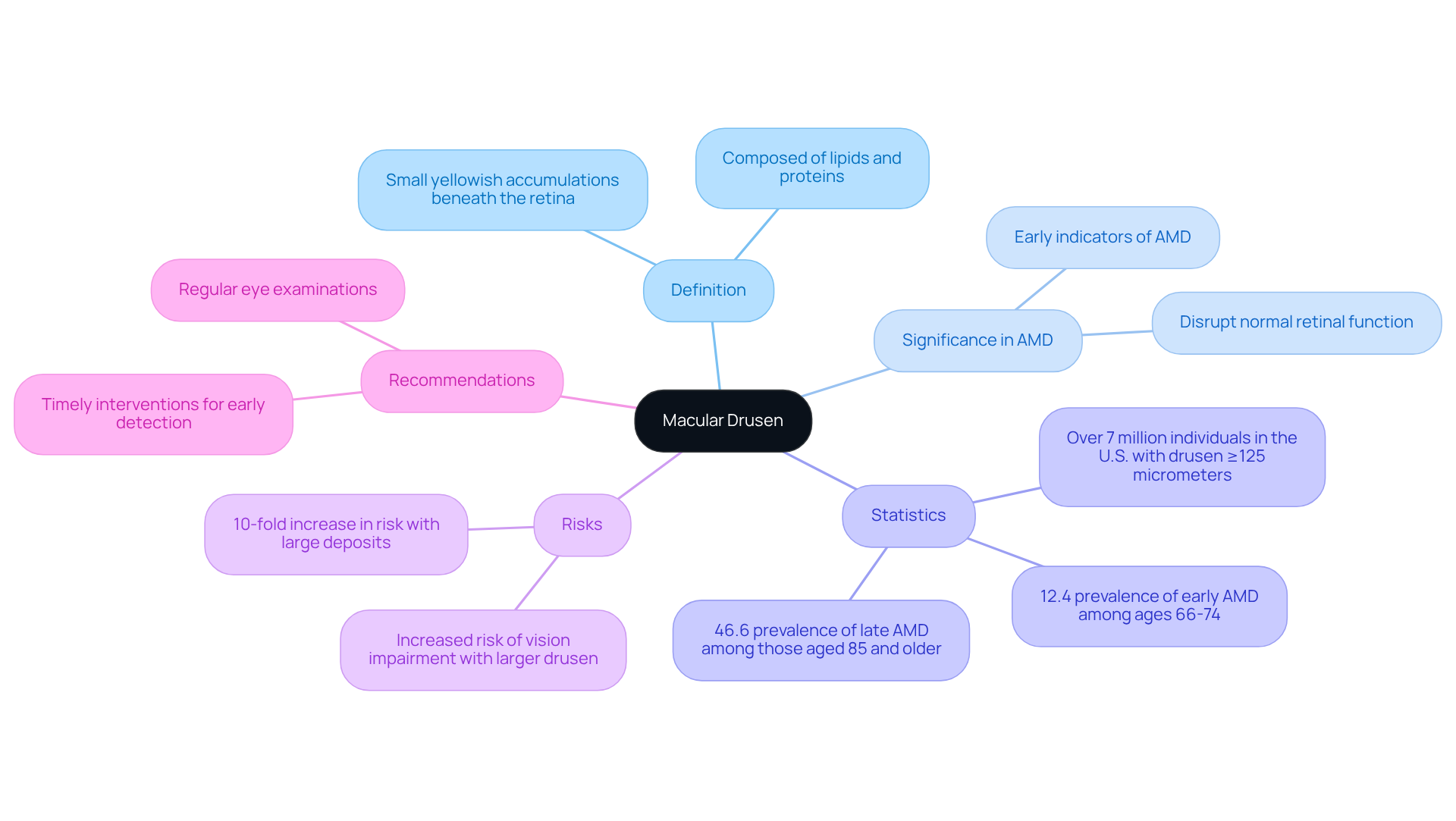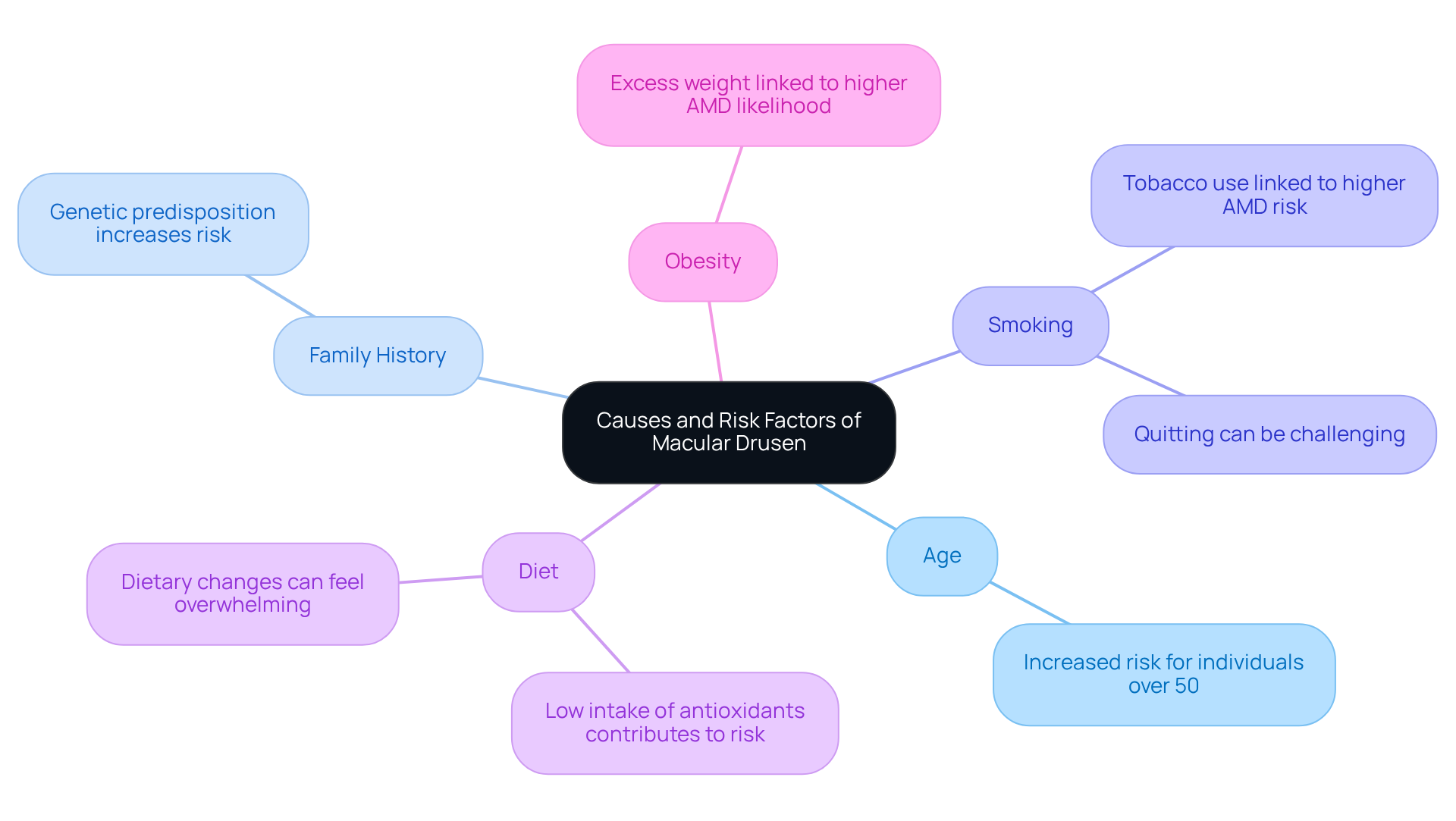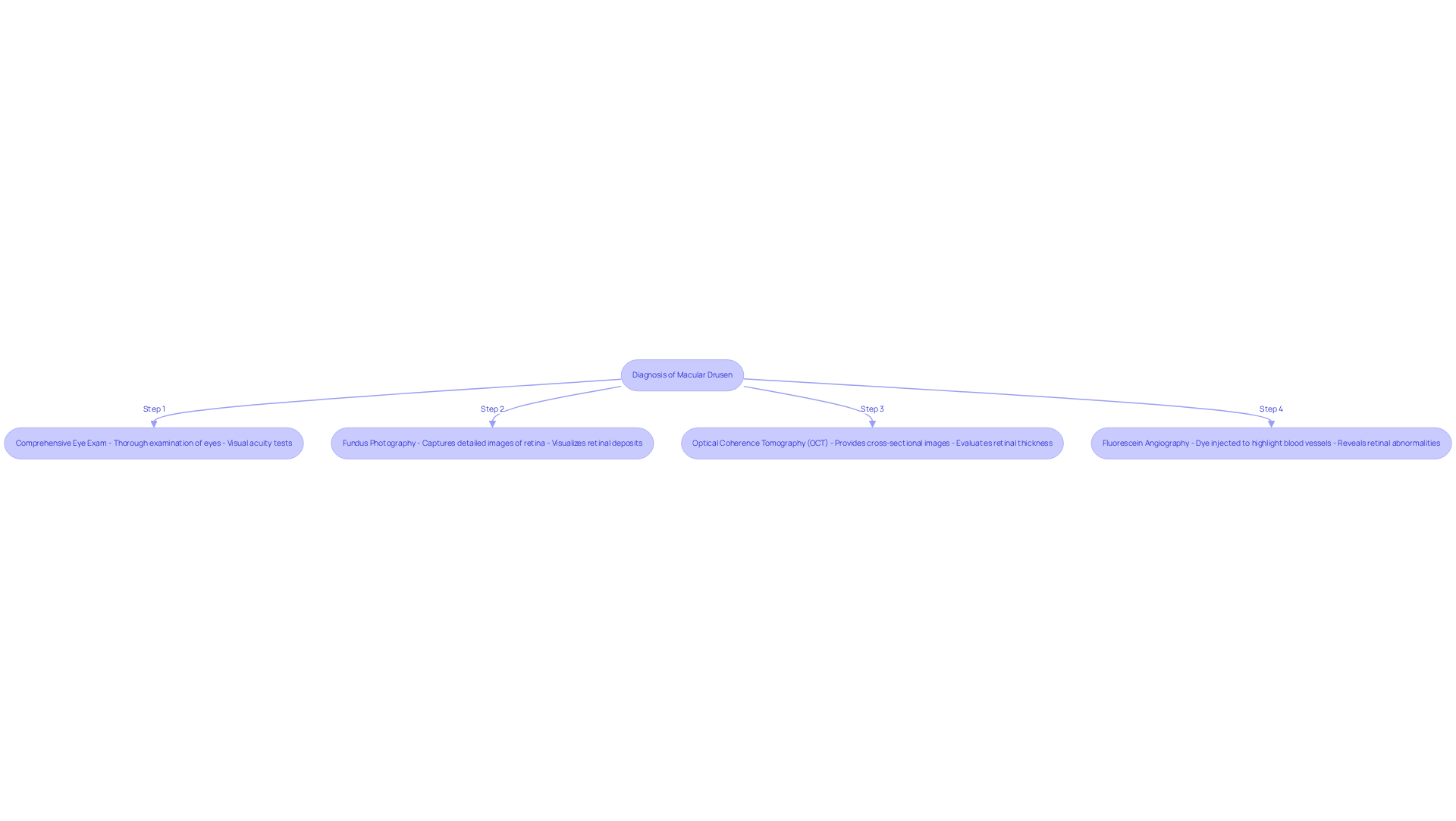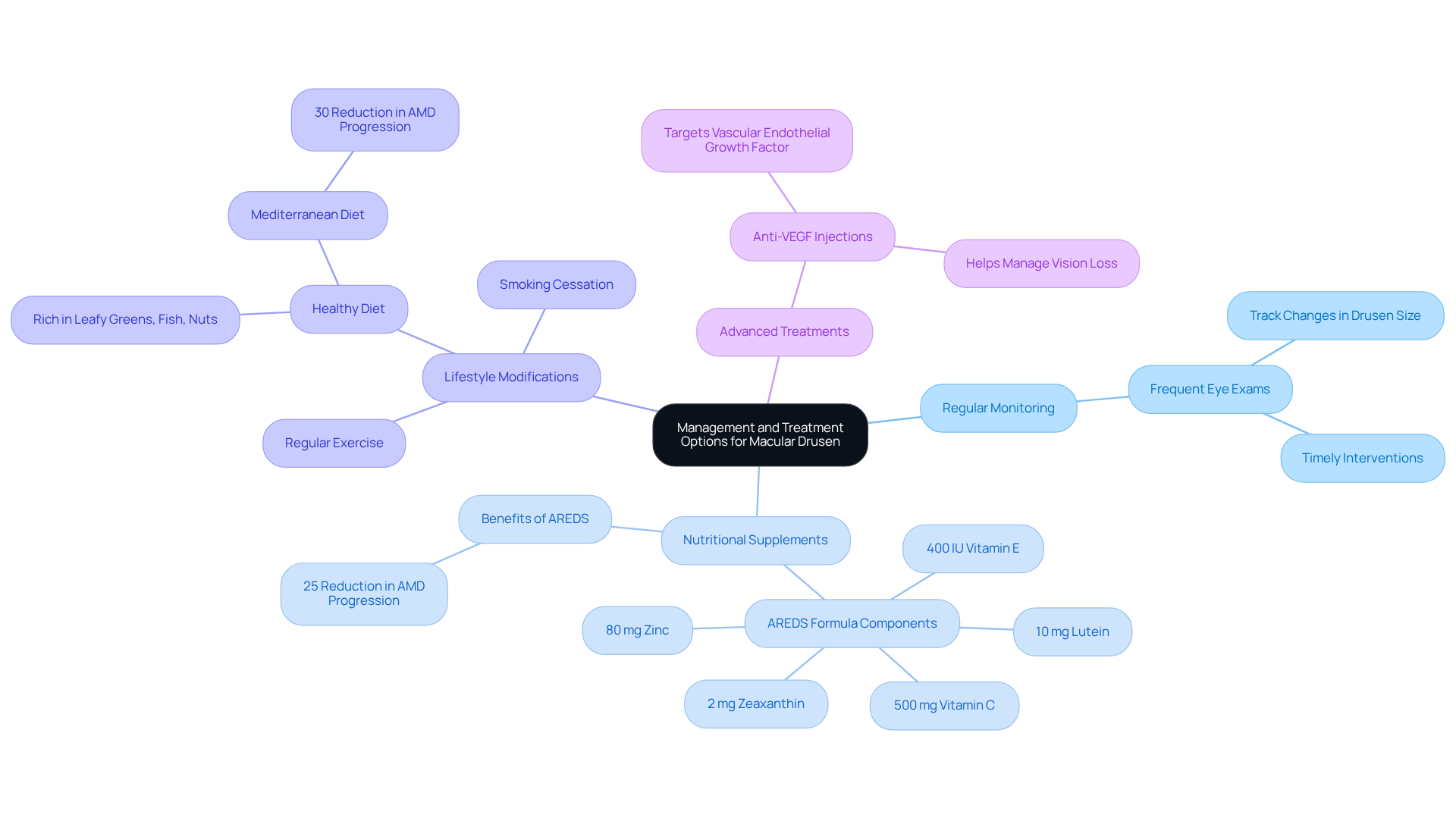Posted by: Northwest Eye in General on October 2, 2025
Overview
This article aims to help you understand macular drusen, which are important indicators of age-related macular degeneration (AMD) that can lead to vision impairment. We understand that concerns about vision can be overwhelming. That’s why we emphasize the importance of early detection through regular eye exams.
In this article, we will outline the causes of AMD, the diagnostic procedures involved, and various management strategies. It’s common to feel uncertain about what steps to take next, but rest assured that lifestyle modifications and nutritional supplements can effectively slow disease progression and support your eye health.
We are here to help you through this process and encourage you to seek care. Remember, taking proactive steps today can make a significant difference in maintaining your vision for the future.
Introduction
Macular drusen, those small yellowish deposits beneath the retina, are more than just a benign occurrence; they serve as critical indicators of age-related macular degeneration (AMD), a leading cause of vision loss. We understand that discovering such information can be concerning, but recognizing these accumulations empowers individuals to take proactive steps in protecting their eye health. They signal the need for regular monitoring and potential intervention, which can help safeguard your vision.
However, with millions at risk and many unaware of their presence, it’s common to feel overwhelmed. The question arises: how can one effectively navigate the complexities of diagnosis and management of macular drusen? We are here to help you through this process, ensuring you feel supported and informed every step of the way.
Define Macular Drusen and Its Significance in Eye Health
Macular drusen are small yellowish accumulations that build up beneath the retina and are primarily associated with age-related macular degeneration (AMD). These deposits, made up of lipids and proteins, can vary in size and number. Larger formations may pose a greater risk for vision impairment. It’s important to recognize that the presence of these deposits can disrupt the normal functioning of the retina, leading to significant vision problems. We understand that this can be concerning; studies indicate that over 7 million individuals in the U.S. have eye deposits measuring 125 micrometers or larger, placing them at substantial risk for developing AMD.
The importance of macular drusen in AMD cannot be overstated; they serve as early indicators of the disease. Regular eye examinations are essential for monitoring the presence of macular drusen and assessing their impact on eye health. For instance, a recent study emphasized that early detection of AMD through recognizing macular drusen can lead to timely interventions, potentially preventing severe vision loss. It’s common to feel anxious about your eye health, but ophthalmologists stress that identifying individuals with a high chance of AMD, especially those with macular drusen, is crucial in decreasing the probability of blindness from this condition. As Paul Mitchell, MD, PhD, FRACO, observes, ‘The discovery of macular drusen or indistinct soft deposits, along with any large deposits covering an area half that of the optic disc, raises the risk by 10-fold.’
Recent research has shown that the prevalence of early AMD is notably high among older adults, with 12.4% of individuals aged 66-74 exhibiting early signs of the disease. Furthermore, the prevalence of late AMD increases significantly with age, reaching 46.6% in those aged 85 and older. These statistics highlight the significance of understanding macular drusen and their role in vision health. We are here to help you through this process, as macular drusen are essential for the early detection and management of AMD.

Explore Causes and Risk Factors of Macular Drusen
The formation of macular drusen can be influenced by various factors, and we understand that this can be concerning. Key risk factors include:
- Age: Individuals over 50 are at a higher risk, and it’s common to feel anxious about this.
- Family History: A genetic predisposition can raise the chances of developing eye deposits, which can be difficult to process.
- Smoking: Tobacco consumption is associated with an increased likelihood of AMD and the development of deposits, and we know that quitting can be a challenging journey.
- Diet: Poor nutrition, particularly low intake of antioxidants, can contribute to retinal health decline, and making dietary changes can feel overwhelming.
- Obesity: Excess weight is linked to a higher likelihood of AMD, which can add to your concerns about overall health.
Comprehending these risk factors is essential, as it empowers you to implement lifestyle modifications that may lower your chances of developing macular drusen and other related vision issues. Remember, we are here to help you through this process and support your journey towards better health.

Detail Diagnostic Procedures for Identifying Macular Drusen
We understand that receiving a diagnosis of macular drusen can be concerning. To help you navigate this process, diagnosing macular drusen typically involves several key procedures that your ophthalmologist will guide you through:
- Comprehensive Eye Exam: Your ophthalmologist will conduct a thorough examination of your eyes, including visual acuity tests to assess your vision.
- Fundus Photography: This imaging method captures detailed images of your retina, enabling the visualization of any retinal deposits that may be present.
- Optical Coherence Tomography (OCT): OCT provides cross-sectional images of the retina, aiding in the evaluation of its thickness and the existence of any deposits.
- Fluorescein Angiography: In this test, a dye is injected into your bloodstream to highlight blood vessels in the retina, revealing any abnormalities that may need attention.
These diagnostic instruments are crucial for precisely recognizing macular drusen and establishing suitable management approaches. Remember, we are here to help you through this process, ensuring you feel supported every step of the way.

Outline Management and Treatment Options for Macular Drusen
Management and treatment choices for macular drusen focus on monitoring and preventing the progression to more severe stages of age-related macular degeneration (AMD). We understand that navigating this condition can be challenging, and we want to provide you with the necessary strategies to help you maintain your eye health. Here are some key approaches to consider:
- Regular Monitoring: Frequent eye exams are essential to track changes in drusen size and number. This allows for timely interventions, which can be reassuring as you manage your condition.
- Nutritional Supplements: The AREDS (Age-Related Eye Disease Study) formula, which includes 500 mg of vitamin C, 400 IU of vitamin E, 80 mg of zinc, 10 mg of lutein, and 2 mg of zeaxanthin, has been shown to lower the likelihood of progression to advanced AMD by approximately 25%. This highlights the potential of nutritional supplements in effectively managing macular drusen.
- Lifestyle Modifications: Adopting a healthy diet rich in leafy greens, fish, and nuts, along with regular exercise and smoking cessation, can significantly impact AMD progression. It’s common to feel overwhelmed, but studies indicate that individuals following a Mediterranean diet experience an almost 30% reduction in the risk of advancing from moderate to late macular degeneration.
- Advanced Treatments: In cases where macular drusen lead to significant vision loss, treatments such as anti-VEGF injections may be considered. These injections target vascular endothelial growth factor (VEGF), a key player in the progression of AMD, and can help manage vision loss effectively.
By understanding these management strategies, you can take proactive steps to protect your vision and overall eye health. Remember, while nutritional supplements can aid in slowing progression, they should be part of a comprehensive approach that includes regular monitoring and lifestyle changes. We are here to help you through this process, and together we can work towards maintaining your eye health.

Conclusion
Understanding macular drusen is crucial for maintaining eye health, especially concerning age-related macular degeneration (AMD). These small deposits beneath the retina can serve as early indicators of potential vision impairment. We recognize how concerning this can be, and understanding their significance, along with the associated risks, can empower you to take proactive steps in monitoring your eye health and seeking timely interventions.
This article highlights several key aspects of macular drusen, including their causes, risk factors, diagnostic procedures, and management strategies. Factors such as:
- Age
- Family history
- Smoking
- Diet
- Obesity
play a significant role in the development of these deposits. Regular eye examinations and advanced diagnostic techniques are essential for identifying macular drusen. Additionally, management options like nutritional supplements and lifestyle modifications can help mitigate the progression of AMD.
Ultimately, awareness and education about macular drusen are vital for preserving vision health. We encourage you to prioritize regular eye check-ups and consider lifestyle changes that promote retinal well-being. By staying informed and proactive, the risks associated with macular drusen can be effectively managed, enhancing your chances of maintaining healthy vision for years to come. Remember, we are here to help you through this process.
Frequently Asked Questions
What are macular drusen?
Macular drusen are small yellowish accumulations made up of lipids and proteins that build up beneath the retina, primarily associated with age-related macular degeneration (AMD).
Why are macular drusen significant in eye health?
Macular drusen are significant because they serve as early indicators of age-related macular degeneration (AMD), which can lead to vision impairment. Their presence can disrupt the normal functioning of the retina, resulting in significant vision problems.
How do macular drusen relate to the risk of developing AMD?
The presence of macular drusen, particularly larger formations, increases the risk of developing AMD. Over 7 million individuals in the U.S. have eye deposits measuring 125 micrometers or larger, placing them at substantial risk for AMD.
What role do regular eye examinations play in relation to macular drusen?
Regular eye examinations are essential for monitoring the presence of macular drusen and assessing their impact on eye health, allowing for early detection and timely interventions to prevent severe vision loss.
What statistics highlight the prevalence of AMD among older adults?
Recent research indicates that 12.4% of individuals aged 66-74 exhibit early signs of AMD, and the prevalence of late AMD increases significantly with age, reaching 46.6% in those aged 85 and older.
How can identifying macular drusen affect the likelihood of blindness from AMD?
Identifying individuals with a high chance of AMD, especially those with macular drusen, is crucial in decreasing the probability of blindness from this condition, as early detection can lead to timely interventions.






